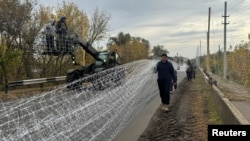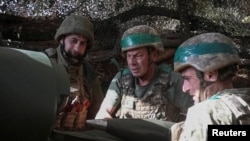Since midsummer, Ukrainian forces have played a game of whack-a-mole in Pokrovsk, watching individual Russian soldiers and small units pop up in building ruins or basements in the frontline Donetsk region city, and then hammering them one by one.
On the city’s eastern and southern perimeters, meanwhile, Russian forces have crept forward, seizing roads, slowly strangling supply lines, and pressuring Ukrainian defenses.
Earlier this month, Russian forces managed to cement a more stable foothold inside the ruined city, as Ukrainian troops, under pressure in other locations to the north, like Kupyansk, struggled to hold them back.
It may be too late, experts warn.
"The situation in Pokrovsk is on the verge of critical and continues to deteriorate until it may be too late to fix everything," analysts with the DeepState project, which has ties to the Ukrainian military, warned on October 29.
Russian troops “managed to infiltrate Pokrovsk early last summer, but the Ukrainians knocked them out,” Pasi Paroinen, a Finnish analyst with the open-source organization Black Bird Group, told RFE/RL’s Ukrainian Service. “This time, I think it is unlikely that the Ukrainians will be able to completely knock them out of Pokrovsk.”
Underscoring Ukraine’s precarious hold, the country’s top military commander, General Oleksandr Syrskiy, said on October 30 that he traveled to the area.
“The situation is difficult, but the statements of Russian propaganda about the supposed ‘blockading’ of Ukrainian forces in Pokrovsk, as well as in Kupyansk, do not correspond to reality,” he said in a post to Telegram. “At the same time, in Pokrovsk, enemy infantry avoid clashes, gather in urban areas, change locations, so the primary task is to detect and destroy them.”
Infiltration
Sitting astride two major highways -- one heading west to the Dnipropetrovsk region and the city of Dnipro, one heading northeast to the railway junction city of Kostyantynivka -- Pokrovsk has been a linchpin of Ukraine’s defense on the central and southern stretches of the 1,100-kilometer front line.
Also a rail hub, the city had a prewar population of about 60,000; only a few thousand residents remain, defying exhortations and orders to evacuate.
For more than a year now, Russian forces have employed the tactic of sending soldiers -- one or two at a time or in small groups, on motorcycles or all-terrain vehicles -- to try and race past Ukrainian lines, which are frequently porous and stretched thin. The tactic is deadly, one of the reasons Russian casualties have been astronomical. But it’s effective in evading Ukrainian drones and slipping past foxholes or bunkers.
Russian troops have also disguised themselves as civilians, Ukrainian soldiers said, making it harder to target them.
In August, Russia troops used that tactic to wedge a gap in Ukraine’s defenses northeast of Pokrovsk, near the village of Dobropillya. Ukraine rushed in reinforcements, including units from the battle-hardened Third Separate Assault Brigade, to plug the gap, and they managed to encircle a number of Russian units.
Sometime around the second week of October, a Russian sabotage and reconnaissance unit fought its way into the city, around the central railway station, according to the 7th Rapid Reaction Corps of the Airborne Assault Forces. After allegedly killing an unknown number of civilians, the Russians then pushed northeast.
"It feels like they just came out of the ground. Maybe they've been hiding in the houses since the first time they came in," one deputy brigade commander was quoted as telling the Ukrayinska Pravda newspaper.
As of October 29, Ukrainian soldiers estimate that between 200 and 400 Russian troops have currently lodged themselves in the city’s eastern districts, and Ukrainian officials have reported fierce street fighting.
“It's pretty clear that they're already inside the city and operating there in significant numbers,” Paroinen said.
“It is not difficult to track them,” Junior Lieutenant Serhiy Okishev, a spokesman for the 7th Corps, told RFE/RL’s Donbas Realities. “It is difficult to resist them due to the enemy’s numerical superiority, both in terms of manpower and destructive power. This includes artillery and strike [drones], and primarily guided aerial bombs.”
Immediately to the east of the city is the town of Myrnohrad, which sits on the T0504 highway and is home to the Ukrainian units holding back a creeping encirclement. If Myrnohrad falls, the entire highway supply route is at risk, said Denys Popovych, a Ukrainian military analyst.
"If Pokrovsk is captured, it will be fatal for Myrnohrad,” Popovych told Current Time, and “then that opens the road to the Dnipropetrovsk region. It will be possible to plan a further advance along a broad front.”
'We’ll Cope'
As Ukraine’s defense in Pokrovsk frays, frustration has started spilling out.
“It’s sad that by the end of the fourth year of full-scale war, there is still no organized system for defending urban areas -- something that has already cost us dearly and continues to do so,” one Ukrainian officer, who uses the call sign “Oleks,” said in a post to Telegram last week.
"I have repeatedly raised the issue of regrouping and the absence of a second line of defense, which will lead to our units being encircled, but they don't listen to us," an unnamed brigade commander told Ukrayinska Pravda.
"I don't see us winning on the Pokrovsk front. It's very sad,” said a soldier from the 68th Separate Jaeger Brigade who asked to use only his call sign, Volt.
“Why is that? We lack the means to combat them,” he told Current Time. “And the relevant artillery. The enemy's electronic warfare is effective, the enemy's radar. We lack intelligence. That's the situation. What else can I say? We'll cope, everything will be fine.”
“The situation in Pokrovsk is getting worse,” Serhiy Sternenko, a Ukrainian activist and popular blogger known for crowdfunding drones for the military, said in a post to X. “Logistics as such are nonexistent. Individual positions are located behind enemy lines. Why behind enemy lines? Because there's no unified front line.”



















